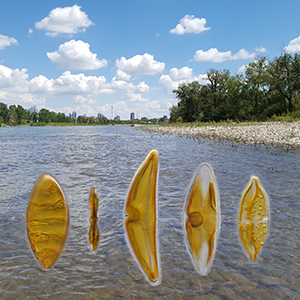Exploring diatom diversity through cultures - a case study from the Bow River, Canada

Accepted: 18 November 2022
HTML: 11
All claims expressed in this article are solely those of the authors and do not necessarily represent those of their affiliated organizations, or those of the publisher, the editors and the reviewers. Any product that may be evaluated in this article or claim that may be made by its manufacturer is not guaranteed or endorsed by the publisher.
Authors
Diatom cultures can help answer taxonomic, biogeographic and ecological questions on a local and global scale. Unialgal cultures are derived from a single cell and provide abundant material for morphological and molecular analyses. The link between the historic morphological species concept and the molecular data is becoming increasingly important with the use of eDNA metabarcoding. Additionally, cultures provide insights into the life cycle of diatoms and thereby complement taxonomy and species ecology. In this study, we present an approach to extract benthic diatoms from an environmental sample to generate unialgal cultures. We explored diatom diversity in preserved assemblages and by culturing as many different taxa as possible from benthic freshwater samples taken on the same day from the Bow River in Calgary, Canada. With both methods we found a total of 221 different benthic diatom taxa, of which 182 were identified in the preserved diatom assemblages. Interestingly, an additional 39 taxa only appeared in the cultures. In total 129 strains were cultivated representing 71 different taxa. This study includes pictures of living cells demonstrating the additional merits of unialgal cultures, as they provide information on plastid details, auxospores and endosymbionts. Both, the identification of the diatom assemblages and the generation and identification of strains provide the foundation for additional water quality assessment tools, taxonomic insights and molecular references libraries.
Edited by
Francesca Bona, Department of Life Sciences and Systems Biology, University of Turin, ItalySupporting Agencies
Verein der Freunde des Botanischen Gartens und Botanischen Museums Berlin Dahlem e.V. , Federal Ministry of Education and Research (German Barcode of Life 2 Diatoms, GBOL2)How to Cite

This work is licensed under a Creative Commons Attribution-NonCommercial 4.0 International License.
Similar Articles
- Jianming Deng, Yunlin Zhang, Boqiang Qin, Xiaolong Yao, Yubing Deng, Trends of publications related to climate change and lake research from 1991 to 2015 , Journal of Limnology: Vol. 76 No. 3 (2017)
- Catherine Pérez Vega, Franz Hölker, Karolina M. Zielinska-Dabkowska, Andreas Jechow, Polarised light pollution on river water surfaces caused by artificial light at night from illuminated bridges and surroundings , Journal of Limnology: Vol. 83 (2024)
- Zsófia Horváth, Csaba Ferenc Vad, Lajos Vörös, Emil Boros, Distribution and conservation status of fairy shrimps (Crustacea: Anostraca) in the astatic soda pans of the Carpathian basin: the role of local and spatial factors , Journal of Limnology: Vol. 72 No. 1 (2013)
- Luciana Avigliano, Alicia Vinocour, Griselda Chaparro, Guillermo Tell, Luz Allende, Influence of re-flooding on phytoplankton assemblages in a temperate wetland following prolonged drought , Journal of Limnology: Vol. 73 No. 2 (2014)
- Rocco Tiberti, Sabino Metta, Martina Austoni, Cristiana Callieri, Morabito Giuseppe, Marchetto Aldo, Michela Rogora, Gabriele A. Tartari, Jost Von Hardenberg, Antonello Provenzale, Ecological dynamics of two remote alpine lakes during ice-free season , Journal of Limnology: Vol. 72 No. 3 (2013)
- Justine R. de Leon, Megumu Fujibayashi, Frances Mikayla Petilla, Bon Ivan Yumul, Milette U. Mendoza-Pascual, Rey Donne S. Papa, Noboru Okuda, Identification of aquatic consumer trophic pathways in four volcanic tropical lakes using fatty acid biomarkers , Journal of Limnology: Vol. 81 (2022)
- Pedro Ramírez-García, David Chicalote-Castillo, Changes in cyanobacterial density due to application of Artificial Floating Island model with macrophytes: an experimental case study in a tropical reservoir , Journal of Limnology: Vol. 80 No. 1 (2021)
- Ana Sanz, Manuel J. López-Rodríguez, Sergio García-Mesa, Cristina Trenzado, Rosa M. Ferrer, J. Manuel Tierno de Figueroa, Are antioxidant capacity and oxidative damage related to biological and autecological characteristics in aquatic insects? , Journal of Limnology: Vol. 76 No. 1 (2017)
- Ratha Sor, Seanghun Meas, Ken K.Y. Wong, Malay Min, Hendrik Segers, Diversity of Monogononta rotifer species among standing waterbodies in northern Cambodia , Journal of Limnology: Vol. 74 No. 1 (2015)
- Walter Ambrosetti, Luigi Barbanti, Angelo Rolla, Leonardo Castellano, Nicoletta Sala, Hydraulic paths and estimation of the real residence time of the water in Lago Maggiore (N. Italy): application of massless markers transported in 3D motion fields , Journal of Limnology: Vol. 71 No. 1 (2012)
<< < 14 15 16 17 18 19 20 21 22 23 > >>
You may also start an advanced similarity search for this article.
-
Katherina Schimani, Nélida Abarca, Oliver Skibbe, Heba Mohamad, Regine Jahn, Wolf-Henning Kusber, Gabriela Laura Campana, Jonas ZimmermannMetabarcoding and Metagenomics : 2023

 https://doi.org/10.4081/jlimnol.2022.2095
https://doi.org/10.4081/jlimnol.2022.2095





